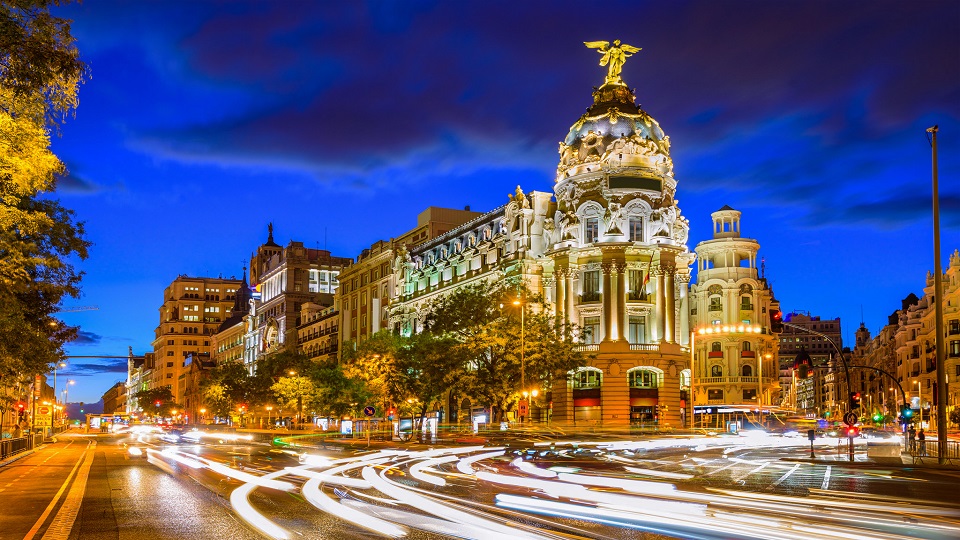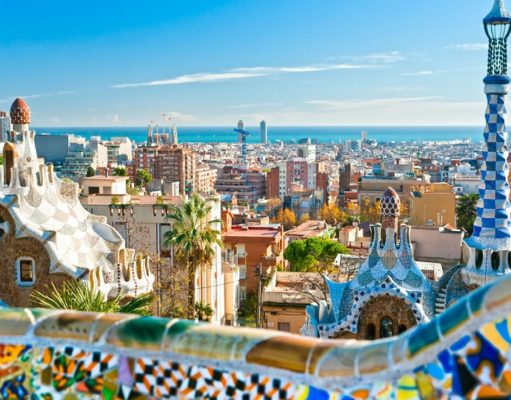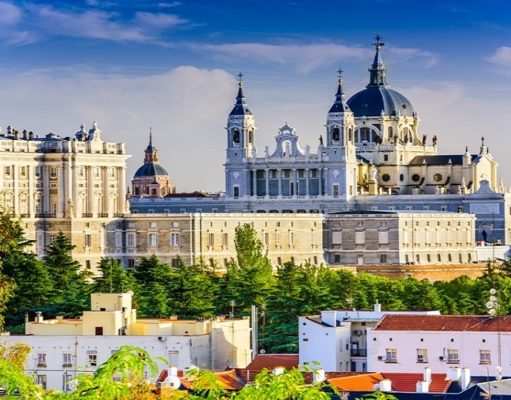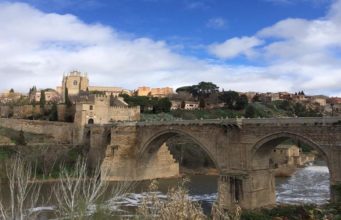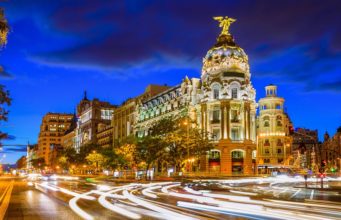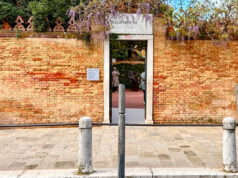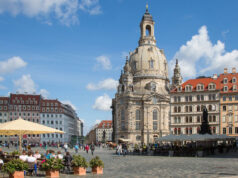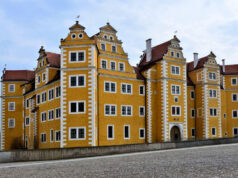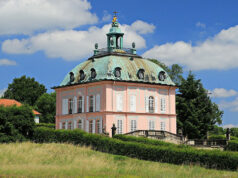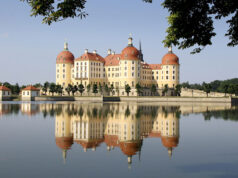Spain is the fourth largest country in Europe bordering with France in the north and Portugal in the west and having a vast coastline in the north-west, south and east. Kingdom of Spain consists of 17 autonomous regions with diverse geography and cultures. Whether you want to go on a cultural trip, visit museums and cathedrals or spend time sightseeing and wine tasting or just relax on one of the many white sand beaches – Spain has all to offer.
Discover Spain
Spain is a land of contrasts and extremes. Whether it comes to its history, architecture, its terrain that includes Mediterranean beaches, snow-capped Pyrenees Mountains, dry plains and volcanic islands, or people who can be warm and welcoming but also loud and expansive. Spain is a big country with many cities and little towns worth visiting. Madrid with its royal grandness, Barcelona with its modern and lively style, Toledo with its ancient charm, Seville with its fiestas or Ibiza with its nightlife – everyone can find a place for himself in this beautiful country.
Spain has a fascinating history. The earliest inhabitants of the Iberian Peninsula (present day Spain and Portugal) were the Celts and the Iberians, but not much is known about this part of the history. These tribes have arrived to the peninsula between 3000 and 2000 BC, but how they got there and from where is still a topic of dispute. For many the modern history of Spain begins with the Romans who controlled the Iberian peninsula for 600 years. They arrived in Iberia in 219/8 BC and left a substantial imprint on its culture and identity.
Spain`s culture is heavily influenced by the rule of the Muslim Moors, who conquered the peninsula in the 8th century AD . The Moors maintained control for nearly 800 years calling the land Al-Andalus. It was a time when three cultures – Islam, Judaism and Christianity coexisted. This had a significant role in the development of Spain. Eventually Al-Andalus fell under the control of the Christians in 1492, whose control over Europe has taken immense power at that time.
The 16th century marked the “Golden Age” of Spain, when it became Europe`s most powerful country which lasted almost 2 centuries. The end of the 17th century saw the beginning of the end of the Spanish hegemony. This is a time when France and England increased their imperial power. This shift coincided with the end of the Hapsburg dynasty in Spain, to be replaced at the beginning of the 18th century by the French House of Bourbon (the present King of Spain, Juan Carlos is Bourbon by descent).
18th and 19th centuries were period of political and social instability in Spain, and unlike its northern neighbors it did not undergo an industrial revolution.
After becoming a republic in 1931, the nation was torn apart by a civil war (l936–39). The end of the Spanish Civil War marked the beginning of General Francisco Franco’s repressive thirty six-year regime, which lasted until his death in 1975. Since then, Spain has been a parliamentary monarchy (having both a legislature and a ruler) under King Juan Carlos. Spain joined the European Community in 1986.
Spain occupies about 85 percent of the Iberian Peninsula, which it shares with its smaller neighbor Portugal and is located in the Southwest of Europe. Spain also includes the Canary Islands in the Atlantic Ocean close to the Moroccan coast and the Balearic Islands (Mallorca, Menorca and Ibiza ) in the Mediterranean Sea. Spain’s average elevation is the second-highest in Europe after Switzerland.
Landscapes of Spain are extremely varied having some dessert-like plains, and others green and fertile. Lets not forget the coasts of Spain adding up to over 1,600 kilometers in length which makes it one of the longest coastlines in the Mediterranean.
Spain has a population of some 40 million people, with a much lower population density than most other European countries. Geographic barriers have helped preserve a keen sense of identity in all six of Spain’s major ethnic groups. The Castilians, who live in the central Meseta, are the nation’s dominant group, and Castilian Spanish is Spain’s national language. The other groups are the Galicians, Basques, Catalans, Levante, and Andalusians.
 Spain has a complex mix within its culture based on its history and various influences. Modern day Spain is well known for its flamenco music and dances, the traditional bullfights, fiestas, literature, architecture and more.
Spain has a complex mix within its culture based on its history and various influences. Modern day Spain is well known for its flamenco music and dances, the traditional bullfights, fiestas, literature, architecture and more.
Nowadays Spain is one of the culture centers of Europe and its artistic heritage is second to none. Francisco de Goya, Pablo Picasso, Salvador Dali are some of the painters who left their undying mark on the Spanish and global cultural legacy.
The invention of the Spanish guitar (1970) is also a significant moment in Spanish and world culture.
The national language of Spain is Castilian. It is spoken by a majority of Spaniards and used in the schools and courts. Castilian is a Roman (Latin-based) language, as are most of the other regional languages, including Catalan and Galician. Basque is a pre-Roman language whose origin has not been clearly determined.
Spain is one of the most staunchly Catholic countries. Over 95 percent of the Spanish people are Roman Catholic. Many Spaniards observe baptism and other important Catholic rites but do not attend church regularly. Spaniards, like the Catholics in other countries, believe strongly in divine help from the saints and especially from the Virgin Mary.
Spaniards are considered to be friendly and outgoing. It is customary to kiss each other on the cheeks between friends and personal space is a tabu. They eat dinner and go to bed late. After work people usually finish their day with a walk (paseo) with friends or family and/or go to bars for drinks, appetizers (tapas), and conversation.
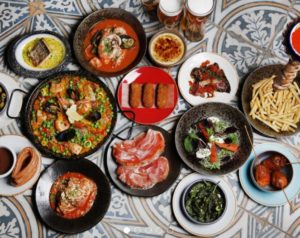 As you can imagine Spain, with its great climate and perfect geographical position, is quite the place for yummy locally-grown deliciousness. Among the top-used ingredients in its cuisine are olive oil, garlic, paprika, sherry vinegar (produced as a result of the fermentation of sherry wine), basil and tomatoes.
As you can imagine Spain, with its great climate and perfect geographical position, is quite the place for yummy locally-grown deliciousness. Among the top-used ingredients in its cuisine are olive oil, garlic, paprika, sherry vinegar (produced as a result of the fermentation of sherry wine), basil and tomatoes.
The Spanish diet is among the world’s healthiest. One can always find fresh fruits and veggies, olive oil in abundance, herbs, good carbohydrates and other Mediterranean food variety in a Spaniard’s kitchen.
Breakfast is definitely small. A cup of coffee or chocolate milk with a biscuit or occasionally a toast with some butter and jam will be added. Nothing special.
Locals are snack people and tapas is the proof for that. Tapas are various small dishes, hot or cold, served at almost every restaurant and paired perfectly with drinks. Tapas can consist of cheese or olives, different dips, beans, fried and battered squid or other fish, toasts with different toppings and basically everything that the region offers. The favorite drink of Spain is Sangria – although the traditional recipe is prepared with dry red wine, liquor (rum or brandy), orange juice, fruits and ice – the Sangria has many interpretations of the recipe.
Another favorite beverage, although non alcoholic is Horchatas – a creamy drink slightly similar to almond milk mixed with cinnamon; crackers or biscuits and even perhaps a small sandwich will do the job to keep the energy levels up for a few more hours until lunch.
Everywhere is Spain you can see shops with dozens of hams hanging from the ceiling. These are specialty shops and offers the most loved meat of Spaniards – the Jamon. There are two main labels for this dry-cured ham – Jamon Iberico and Jamon Serrano. The Jamon is similar to the Italian prosciutto but it is cured for longer – up to 18 months. In almost all of these specialty shops one can also choose from and buy various wines, or even sit and have a plate of freshly cut Jamon with a glass of red wine, or can get a sandwich made on the spot with whatever the shop has to offer.
A must try when is Spain is Pimientos de padron – salted, fried in olive oil green peppers. The fun about this snack is that the peppers might be sweet to the palate but there might be just one which is extremely hot!
A salad is usually on the table at lunchtime. A typical one would be mixed salad (ensalada mixta) made out of lettuce, tuna fish, pasta, cherry tomatoes, onions and so on. And bread. Spaniards love their French baguettes, even eating bread alongside other carbs like potatoes or rice (or of course with everyone’s favorite gazpacho cold soup). Vermouth, a type of sweet fortified red wine served straight and usually paired with an olive or a slice of orange that goes well with plates of tapas, is drunk around midday as an aperitif before the main lunch meal, which can be simply roasted fish with a generous drizzle of olive oil and some herbs. Desserts are also light and simple – preferably some fresh or canned fruit.
Another quick snack and in the blink of an eye it is time for dinner (disclaimer: just kidding, in fact there is quite a few hours in between lunch and dinner; Spaniards tend to eat late compared to other nations – for instance, lunch at around 2pm and dinner at around 9pm). Typical main dishes include tortilla española, an omelette made with eggs and potatoes, sometimes also with onion and/or chives or garlic; well-known paella, a dish of white rice with seafood or meat, veggies and beans. The dessert after dinner is often a flan – custard dessert with a layer of clear caramel sauce, rice pudding or other similar sort of dessert. Another traditional and favorite sweet treat is the Churro – fried dough pastry paired with and dipped in hot chocolate.
All in all, Spain has all it takes for a foodie to book a flight there right away. Rich local produce, olive oil bliss, fresh fish, crusty baguettes, fun alcoholic and not so drinks.
 With its long coastline, it is no surprise than Spain relies on fishery. Not only is it an integral part of people’s diet there, but also a profitable export. The seafood variety is rich in tuna fish, needle fish, cod, herring, sardines, octopus, shrimp and prawn.
With its long coastline, it is no surprise than Spain relies on fishery. Not only is it an integral part of people’s diet there, but also a profitable export. The seafood variety is rich in tuna fish, needle fish, cod, herring, sardines, octopus, shrimp and prawn.
With its perfect geographical location it is no surprise that Spain is boasting with an enormous Wine produce, making it the third largest wine producer in the world after Italy and France. The most popular wine regions are La Rioja, Ribera dell Duero and Cava. Another interesting fact is that a Spanish company naturally creates blue wine. Gik Live comes from Basque country and contains no artificial coloring. The organic wine can be purchased even online at the cost of around 15 USD per bottle.
A bota bag is a traditional Spanish drinking vessel. Another word for it is wineskin, as most often people drink wine out of it. If you want to try it ask a local to show you how it is done – the bota must be angled in a special way so that you the liquid is shot out right into your mouth. Also, it’s a more hygienic way to share with friends, just like Spaniards do, and an interesting souvenir to take back home.
Spain is also one of the world’s largest producers of saffron. The cost of this precious spice may seem a bit higher than at other places but it is because the produce comes mostly from family farms and traditional cultivation. Definitely grab some if the culture of Spain inspired you to get creative in the kitchen.
Speaking of food, buying an authentic Paella pan is a must for cooks. It can be easily purchased from Valencia, the home of paella, but from other places as well. A very authentic gifts not just for you, but sure for mamas and nanas also.
Spain is a leading country for pharmaceutical produce. Many sources promise excellent medical treatment in Spain for EU citizens (if you are one, check out European Health Card which titles the recipient access to the great healthcare fund in the country) and all other foreigners.
The agriculture in Spain is diverse and the soil is good for everything from citrus fruits to cereal grains, olives, grapes. The shoppers tend to be in search for fresh and healthy produce which provokes supermarkets to offer of it more and more.
Spain boasts a few local car brands with the most famous one being SEAT. It is the only one of Spanish brands with a mass production potential and capability of developing its own models in-house. Beside this Spain is also Europe’s second largest automobile producer after Germany. There are many manufacturers in the country, among which is SEAT, Opel, Nissan, Renault and Volkswagen.
These are our top recommendations for visitors to Spain. Why the Faber dozen?
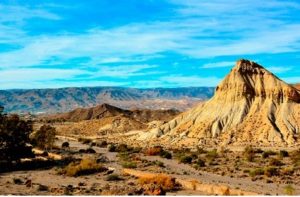 1. 20 miles north-west of Almeria is Europe’s only desert, Desierto de Tabernas. Not only can one spot yellow scorpions and black widow spiders there but also the places where ‘’Spaghetti Westerns’’ were shot.
1. 20 miles north-west of Almeria is Europe’s only desert, Desierto de Tabernas. Not only can one spot yellow scorpions and black widow spiders there but also the places where ‘’Spaghetti Westerns’’ were shot.
2. Cap de Creus – legend says that the cape was hewn by Hercules; Port Lligat is a small village located there where the home of Salvador Dali is a present museum and can be visited; the artist depicted the peninsula in his painting The Persistence of Memory
3. Campo del Moro, the Royal Palace gardens were named by the troops of the Muslim leader Ali ben Yusuf that camped there in attempt to reconquer Madrid; Later Philip IV built fountains and planted vegetations, the overall look of the Gardens though flourished during the reign of Isabel II
4. Every Year more and more tourists are drawn into the Canary Islands, a Spanish archipelago off the coast of northwestern Africa because of its sub-tropical climate, diving experiences during which one can see the endangered Loggerhead Turtle (one of the largest hard-shelled turtles in the world) and The Carnival of Santa Cruz de Tenerife in February – world’s second biggest carnival after the one in Rio de Janeiro.
5. Calat Alhamra, a palace and fortress complex located in Granada, Andalusia, is a well-known tourist attraction which encompasses both stunning Islamic and Christian architecture and atmosphere.
6. Logroño, the pearl of traditional and modern times, is a city in La Rioja – the Province most famous for its unique wine. The city has over 50 taperías (tapas restaurants) located within a four-block area near the town center. The Pilgrim’s Route to Santiago de Compostela made this one of the most important towns on the route. River Ebro flows through the city and its bank is a relaxing area for locals.
7. Spain’s highest point, Mount Teide (3, 718m or 12, 200ft) is the highest point above sea level in the islands of the Atlantic; it is an active volcano which has last erupted more than a century ago; Also, Teide National Park is Europe’s most visited with 3 million visitors per year.
8. A hidden gem is definitely Reus or as others call it Gaudi’s town. It is sure worth visiting the hometown of the artist and getting lost amidst the rich artistic heritage the place has to offer.
9. Another great place to visit while in Spain is Zaragoza – the city has been ruled by the Romans, The Moors and the Christian Kings and needless to say all these years of history have left a mark on every aspect of the city – from architecture to food, traditions and cultural diversity. Not only that but also Zaragoza is near both Barcelona and Madrid (2-3 hours away by bus/train) which makes it a perfect destination for those wanting to do more travelling within the country.
10. East of Burgos is the large archaeological site of Atapuerca – caves which contain rich fossil record of the earliest Europe humans. Someone excited about history and archaeology would absolutely love this place as well as the Museum of Human Evolution in Burgos.
11. Carche is the spot for all adventurers! Located in the region of Murcia this sparsely populated mountainous area has everything to offer from a beautiful Regional Park called Sierra del Carche to salt flats, an aqueduct and abundant presence of flora and fauna.
12. Located inland of Spain, the city of Albacete will surprise you with its charm and beauty. Some wandering around Abelardo Sánchez Park would without doubt let one feel refreshed and at ease. If you are familiar with the game of bochas also visit Fiesta del Árbol Park where locals play.
13. The Basque Country is one of the few regions that was never conquered by the Romans and the Moors. This mere fact has preserved the language and culture of the locals unique. San Sebastian though, a coastal city in the Region, is rather touristy and modern, and attracts many with its charming old city center that has tons of bars.
14. Tajo, or the Tagus River is the the longest in the Iberian Peninsula. Many dams and hydroelectric stations utilize its waters . The River flows through the heart of Spain and Portugal and supply people with drinking water. Currently, many residents are concerned by the River drying out as a result of human activities and are thinking on ways to preserve it.
15. Universidad de Salamanca (University of Salamanca) is the oldest university in the Hispanic world and one of the very few such still operating today. Not only are its classrooms an abiding place to hundreds of Latin-Americans but also students and professionals from altogether 60 nationalities go there to grow intellectually.
Practical Matters
There are many airports around Spain and its islands, the busiest ones being in Madrid, Barcelona, Palma de Mallorca and Malaga. It is not a tedious task to fly there as more and more budget-friendly Airlines offer ticket bargains (For instance, Wizz air and Ryan Air are two of the cheapest Europe airlines).
International train and bus transportation are also possible but would be recommended to those living near Spain. There is a direct train from Paris to Barcelona ( 6 and ½ hours) and also bus rides to and from France or Portugal.
A Cruise ferry is an option and a luxurious trip itself. The picturesque ferry ride can take you to Italy, UK and even the dreamy country of Morocco.
The cheapest and most common means of public transportation in Spain is the bus. There is a quite extensive network of excellent routes connecting the major cities day and night. Also, many small villages and coastal areas are accessible only by bus that has started its ride from the capital of the province. Most often the schedules run on time yet consider that Sundays and major holidays are exception and don’t expect much of travel to occur then. Otherwise it’s believed everyone would be pleasantly surprised at the strictness most bus rides are being carried out and the quality of the journey for which one pays indeed not that many euros.
Another very affordable yet efficient means of transportation is the metro. On weekdays it runs frequently and one can not only use it in the capital, Madrid, but also in a few other cities like Barcelona, Seville, Valencia and Granada. Single journey tickets vary in cost but are somewhat between 1 and 2,20 Euros. Kids under the age of 4 use the metro in Madrid for free.
Trains are worth mentioning as well. Spain’s national train company is RENFE and they offer a variety of routes and options for your next adventure. When choosing to travel via train keep in mind that the cost of your ticket can be a bit pricier than the bus ticket although the trains are efficient and comfortable. A good thing is that the youth and older generation can use discounts on some types of tickets (for example, with Renfe Youth Card + 50 travelers under 26 years old can get a 50% discount)
AVE trains is what those of you that need to get somewhere quickly should consider. Running at speeds of up to 310 km/h this extensive network allows for fast connections between cities in Spain. Sure it is not cheap, but who minds getting from Madrid to Barcelona in just three hours?
Booking online tickets for long-distance bus or train rides can result in saving up a bit. Bear in mind that you yourself should print it before the time of travel as most often tickets are sent as PDF files on email after purchasing
Coming Soon
Being home of FC Barcelona and Real Madrid C.F., as one can imagine results in Spain having quite the population of football fanatics. If you are crazy about football, too, take into consideration whether it is a smart idea to go to a football match, especially derbies. They can be dangerous indeed as often involve rivalry, alcohol, violence and smoke bombs.
Yet overall, Spain is a very safe destination in Europe. For you to fully enjoy your trip be cautious in crowded touristy places and don’t take much cash in your purse and other precious possessions/documents. But that should be considered everywhere though, right?
All depends on why you want to go there at first place. As a preferred summer destination for many (mostly Europeans from colder North countries like UK, Belgium, The Netherlands, etc) hotels in the summer are rather costly and fully-booked. Although if you visit Spain for a summer holiday and the coastline is what has caught your attention – then either July or August is the time.
Keep in mind though that the inland gets unbearably hot in the summer (up to 40 degrees Celsius or 100°F) and if you are planning on visiting culturally rich cities like Madrid then perhaps choose Spring or Fall – the weather can vary from warm to rainy and the temperatures get somehow chilly, which sounds good to tourists who go from landmark to landmark.
Winter-lovers get the best deal. If travelling to Spain in cold February doesn’t bother you, then surely you win in life. That is when few people choose this destination as most are staying at home and saving up for sunbathing mud July in Mallorca. Get some cozy clothes and visit anything you heart desires, inland or coastline, and be sure that you will be enjoying tapas and Spain’s gems without much crowdedness all around.
Spain Travel Resources
Coming Soon
Seoul Travel Guidebooks:
Seoul Travel Memoirs:
Coming Soon
Coming Soon

